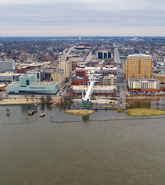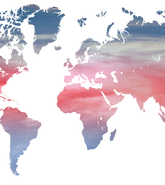Whether you are trying to understand exposure to physical climate risks for a lending portfolio, establish how critical facilities could be disrupted by climate events, or build a TCFD report for your business, it is important to know how your climate risk is estimated, and how its outputs are ultimately validated.
To robustly quantify climate risk means being able to understand your expected damage and business impacts in order to establish what’s at stake and how best to manage the risk to your business.
How those estimates are derived and validated also becomes much more important when considering the importance of making the right financial management decisions – in a world of high uncertainty.
In this blog, we will look at how Moody’s models these numbers using Moody’s Climate on Demand version 2 application, which integrates world-leading physical climate risk modeling from Moody’s RMS, and how this approach is unparalleled in the marketplace of climate risk solutions today.
To learn more about the capabilities of Climate on Demand Version 2, click here.
Credible Physical Risk Modeling
Moody’s RMS pioneered the field of physical risk modeling over the past three decades, and today has 400 risk models covering countries and regions across the globe.
These risk models underpin the highly regulated US$2.5 trillion global insurance industry, with the models now being applied to other sectors such as asset management, investments, credit risk, and loan decisions.
Models are developed and supported by over 1,200 staff, including hundreds of employees with PhDs across a range of disciplines, and all are focused on bringing the latest science and engineering to risk modeling. Moody’s RMS has maintained high levels of R&D investment over the decades, focused on supporting clients to make better financial management decisions.
RMS has also evolved its physical risk financial model, which incorporates a highly granular approach for the assessment of compounding hazard impacts and physical damage along with business impacts that capture the many far-reaching drivers of financial damages to businesses, individuals, and corporates, communities, and governments.
Combining Hazard, Exposure, and Vulnerability Within a Risk Modeling Framework
Moody’s RMS physical climate risk models quantify potential financial impacts using a framework that combines hazard, exposure, and vulnerability.
To understand hazard, the models combine bottom-up weather simulations using climate model output and the latest scientific consensus on climate change, to calculate the expected frequency and severity of weather and climate events both now and in the future.
The vulnerability curves translate hazard into damage and disruption and are developed from engineering studies, regional building codes, and the use of millions of data points from real events. This helps to reflect the local and regional variations that affect how real assets respond to extreme weather events.
Information on the location, value, and characteristics of assets is inputted into the model to obtain a risk calculation in terms of expected financial impact which reflects the unique nature of each asset and portfolio.
Five Core Modeling Components
Each of the five core components used within Moody’s RMS models is validated against more real-world data than any other climate risk product available on the market today, as outlined in the following framework below:
Financial Modeling: The financial models assess the cost to repair and reconstruct a damaged building, to replace its contents, the cost of covering alternative living expenses, and calculate the loss of income and business interruption as a result of the building’s downtime.
Our financial modeling also includes any inflationary effects on the cost of materials and repairs due to demand surges following major catastrophes, additional rebuilding costs incurred due to upgrading older properties to modern-day building standards and codes, and business interruption costs due to the consequences of infrastructure damage such as roads, bridges, and power networks.
Climate impacts and financial loss estimates from the Moody’s RMS financial model are validated using three decades of physical climate impacts experience and leverage insurance claims combined with on-the-ground post-event damage reconnaissance and a deep understanding of climate science, engineering, and financial industry experience.
Bottom-up Event Simulations: Underlying each risk model (e.g. tropical cyclone) are tens of thousands of bottom-up simulations encompassing all the possible events that could occur in any given area. Each event is defined by its location or path, its strength (or intensity) and how these factors evolve through the lifecycle of each event, and the occurrence probability (frequency).
These event sets not just represent past events but all possible future events which can occur in any given area. RMS scientists use the latest peer-reviewed research on climate change together with climate model output to ensure forward-looking projections are in line with the scientific consensus and are as robust as possible.
Hazards: For each event, the models calculate detailed hazard footprints such as windspeed, flood depth, or fire-following earthquake ground-shaking, earthquake liquefaction, etc, for every location affected throughout the entire lifecycle of the event, and take into account factors such as local terrain, geology, land-use, and the built environment.
For example, Moody’s RMS North Atlantic Hurricane Models can calculate the strength of the winds around a storm, the subsequent amount of rainfall and flooding, and storm surge impact from the moment the storm forms out in the ocean until it finally dissipates.
Each time an event happens, Moody’s RMS collects thousands of real-time event data observations. These include detailed measurements from anemometers, rain gauges, coastal buoys, seismometers, or radar images, from numerous public and private data sources.
They can also include on-the-ground Internet of Things (IoT) sensors that can measure real-time data for a hazard at an unprecedented level of detail.
Exposure Details: Moody’s RMS Event Response teams have conducted hundreds of on-the-ground post-event damage reconnaissance surveys all around the world, to capture detailed damage assessments for buildings and facilities.
Machine learning and artificial intelligence techniques are also used to explore how factors such as building age, number of stories, construction type, or building codes, together with individual building characteristics including roof type, and presence of storm shutters and basements, can impact the damage and financial losses experienced at the individual asset level.
Vulnerability: When exposed to the same hazard, a residential building, commercial property, large industrial facility or vehicle, etc. will all experience damage differently.
The vulnerability module within the risk models assesses the degree to which structures and their contents are likely to be damaged by the hazard, including any downtime experienced due to either damage to the building or surrounding infrastructure, or loss of key equipment.
The module also accounts for local architectural styles and regional building codes, construction type, age, and the types of building contents.
Moody’s RMS has gathered billions of dollars of damage, loss, and claims data, which helps to understand the damage and loss experience. This data is also used to improve and validate our risk models whether it is for wildfire, windstorm, winterstorm, flood, earthquake, terrorism, cyber, and so on, and we continue this work for every new event that happens.
For the last 30 years, Moody’s RMS has been the leading provider of physical risk quantification models to the highly regulated (re)insurance industry. Our modelers and support teams are ready to support your need to understand and validate the risk models and data you use to make high-stakes business decisions. meet your regulatory and reporting requirements and protect your business in the long term from the costs of climate change.
For more information on Moody’s RMS Climate on Demand, click here.





